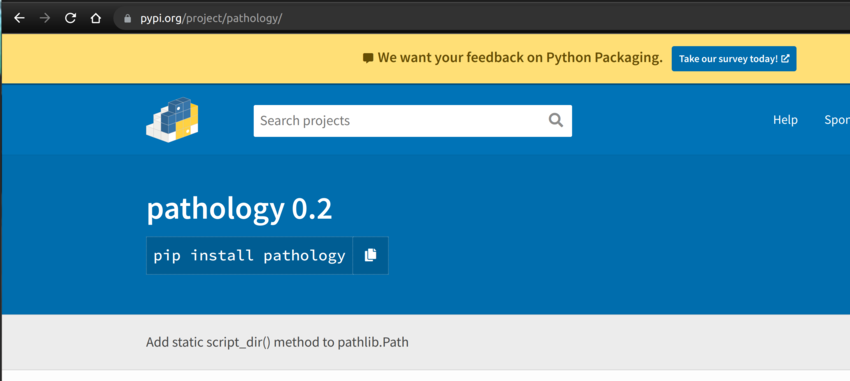Python 函式庫:編寫、打包和分發的綜合指南
Python 是一種出色的程式語言,但打包是其最弱點之一。這是社會上眾所周知的事實。多年來,安裝、導入、使用和創建套件的過程已經有了很大改進,但它仍然無法與 Go 和 Rust 等較新的語言相提並論,後者從 Python 和其他成熟語言的鬥爭中學到了很多東西。
在本教程中,您將學習有關編寫、打包和分發您自己的套件所需的所有知識。
如何寫 Python 函式庫
Python 函式庫是組織為 Python 套件的 Python 模組的連貫集合。一般來說,這意味著所有模組都位於同一目錄下,並且該目錄位於 Python 搜尋路徑上。
讓我們快速寫一個小小的 Python 3 套件並說明所有這些概念。
病理套件
Python 3 有一個優秀的 Path 對象,這相對於 Python 2 笨拙的 os.path 模組來說是一個巨大的改進。但它缺少一項關鍵功能——尋找當前腳本的路徑。當您想要定位相對於目前腳本的存取檔案時,這一點非常重要。
很多情況下,腳本可以安裝在任何位置,因此不能使用絕對路徑,而工作目錄可以設定為任何值,因此不能使用相對路徑。如果要存取子目錄或父目錄中的文件,則必須能夠找出目前腳本目錄。
以下是在 Python 中執行此操作的方法:
import pathlib script_dir = pathlib.Path(__file__).parent.resolve()
要存取目前腳本目錄的「data」子目錄中名為「file.txt」的文件,可以使用以下程式碼: print(open(str(script_dir/' data/file.txt'). read())
使用病理學包,您有一個內建的 script_dir 方法,您可以像這樣使用它:
from pathology.Path import script_dir print(open(str(script_dir()/'data/file.txt').read())
是的,有點拗口。病理包非常簡單。它從 pathlib 的 Path 派生出自己的 Path 類,並添加一個始終返回調用腳本的路徑的靜態 script_dir() 。
這裡是實作:
import pathlib
import inspect
class Path(type(pathlib.Path())):
@staticmethod
def script_dir():
print(inspect.stack()[1].filename)
p = pathlib.Path(inspect.stack()[1].filename)
return p.parent.resolve()
由於pathlib.Path的跨平台實現,您可以直接從它派生,並且必須從特定子類別派生(PosixPath or WindowsPath)。 script_dir 解析使用檢查模組來尋找呼叫者及其檔案名稱屬性。
測試病理套件
每當您編寫的內容不僅僅是一次性腳本時,您就應該對其進行測試。病理學模組也不例外。以下是使用標準單元測試框架的測試:
import os
import shutil
from unittest import TestCase
from pathology.path import Path
class PathTest(TestCase):
def test_script_dir(self):
expected = os.path.abspath(os.path.dirname(__file__))
actual = str(Path.script_dir())
self.assertEqual(expected, actual)
def test_file_access(self):
script_dir = os.path.abspath(os.path.dirname(__file__))
subdir = os.path.join(script_dir, 'test_data')
if Path(subdir).is_dir():
shutil.rmtree(subdir)
os.makedirs(subdir)
file_path = str(Path(subdir)/'file.txt')
content = '123'
open(file_path, 'w').write(content)
test_path = Path.script_dir()/subdir/'file.txt'
actual = open(str(test_path)).read()
self.assertEqual(content, actual)
Python 路徑
Python 套件必須安裝在 Python 搜尋路徑上的某個位置,才能由 Python 模組匯入。 Python 搜尋路徑是目錄列表,並且始終在 sys.path 中可用。這是我目前的 sys.path:
>>> print('\n'.join(sys.path))
/Users/gigi.sayfan/miniconda3/envs/py3/lib/python36.zip
/Users/gigi.sayfan/miniconda3/envs/py3/lib/python3.6
/Users/gigi.sayfan/miniconda3/envs/py3/lib/python3.6/lib-dynload
/Users/gigi.sayfan/miniconda3/envs/py3/lib/python3.6/site-packages
/Users/gigi.sayfan/miniconda3/envs/py3/lib/python3.6/site-packages/setuptools-27.2.0-py3.6.egg
請注意,輸出的第一個空白行代表目前目錄,因此您可以從目前工作目錄匯入模組,無論它是什麼。您可以直接向 sys.path 新增或刪除目錄。
您也可以定義一個 PYTHONPATH 環境變量,還有一些其他方法可以控制它。預設包含標準 site-packages,這是您透過 pip go 安裝軟體套件的位置。
如何打包 Python 函式庫
現在我們有了程式碼和測試,讓我們將其全部打包到適當的庫中。 Python 透過 setup 模組提供了一個簡單的方法。您在程式包的根目錄中建立一個名為 setup.py 的檔案。
setup.py 檔案包含大量元資料信息,例如作者、許可證、維護者以及有關套件的其他資訊。這是對 packages 項目的補充,該項目使用從 setuptools 導入的 find_packages() 函數來尋找子包。
這是病理包的setup.py檔:
from setuptools import setup, find_packages
setup(name='pathology',
version='0.1',
url='https://github.com/the-gigi/pathology',
license='MIT',
author='Gigi Sayfan',
author_email='the.gigi@gmail.com',
description='Add static script_dir() method to Path',
packages=find_packages(exclude=['tests']),
long_description=open('README.md').read(),
zip_safe=False)
來源分發包
來源分發套件是指包含 Python 套件、模組和用於套件發布的其他檔案(例如版本 1、版本 2 等)的存檔檔案。文件分發後,最終用戶可以下載並將其安裝在他們的作業系統上。
要建立來源分發包 (sdist),請執行: python setup.py sdist
讓我們建立一個原始碼發行版:
$ python setup.py sdist running sdist running egg_info creating pathology.egg-info writing pathology.egg-info/PKG-INFO writing dependency_links to pathology.egg-info/dependency_links.txt writing top-level names to pathology.egg-info/top_level.txt writing manifest file 'pathology.egg-info/SOURCES.txt' reading manifest file 'pathology.egg-info/SOURCES.txt' writing manifest file 'pathology.egg-info/SOURCES.txt' warning: sdist: standard file not found: should have one of README, README.rst, README.txt running check creating pathology-0.1 creating pathology-0.1/pathology creating pathology-0.1/pathology.egg-info copying files to pathology-0.1... copying setup.py -> pathology-0.1 copying pathology/__init__.py -> pathology-0.1/pathology copying pathology/path.py -> pathology-0.1/pathology copying pathology.egg-info/PKG-INFO -> pathology-0.1/pathology.egg-info copying pathology.egg-info/SOURCES.txt -> pathology-0.1/pathology.egg-info copying pathology.egg-info/dependency_links.txt -> pathology-0.1/pathology.egg-info copying pathology.egg-info/not-zip-safe -> pathology-0.1/pathology.egg-info copying pathology.egg-info/top_level.txt -> pathology-0.1/pathology.egg-info Writing pathology-0.1/setup.cfg creating dist Creating tar archive removing 'pathology-0.1' (and everything under it)
該警告是因為我使用了非標準的 README.md 檔案。忽略它是安全的。上面的命令將為目前作業系統建立一個預設格式的存檔檔案。對於Unix系統,將在dist目錄下產生一個gzipped tar檔案:
$ ls -la dist total 8 drwxr-xr-x 3 gigi.sayfan gigi.sayfan 102 Apr 18 21:20 . drwxr-xr-x 12 gigi.sayfan gigi.sayfan 408 Apr 18 21:20 .. -rw-r--r-- 1 gigi.sayfan gigi.sayfan 1223 Apr 18 21:20 pathology-0.1.tar.gz
如果您使用的是 Windows,則會產生一個 zip 檔案。
您也可以使用格式選項指定其他附加文件格式,如下所示。
python setup.py sdist --formats=gztar,zip
例如,上述命令将生成一个 gzip 压缩的 tarball 和一个 zip 文件。
可用的不同格式有:
-
zip: .zip -
gztar: .tar.gz -
bztar: .tar.bz2 -
xztar: .tar.xz -
ztar: .tar.Z -
tar: .tar
二进制分发
要创建一个名为“wheel”的二进制发行版,请运行: python setup.py bdist_wheel
这是一个二进制发行版:
$ python setup.py bdist_wheel running bdist_wheel running build running build_py creating build creating build/lib creating build/lib/pathology copying pathology/__init__.py -> build/lib/pathology copying pathology/path.py -> build/lib/pathology installing to build/bdist.macosx-10.7-x86_64/wheel running install running install_lib creating build/bdist.macosx-10.7-x86_64 creating build/bdist.macosx-10.7-x86_64/wheel creating build/bdist.macosx-10.7-x86_64/wheel/pathology copying build/lib/pathology/__init__.py -> build/bdist.macosx-10.7-x86_64/wheel/pathology copying build/lib/pathology/path.py -> build/bdist.macosx-10.7-x86_64/wheel/pathology running install_egg_info running egg_info writing pathology.egg-info/PKG-INFO writing dependency_links to pathology.egg-info/dependency_links.txt writing top-level names to pathology.egg-info/top_level.txt reading manifest file 'pathology.egg-info/SOURCES.txt' writing manifest file 'pathology.egg-info/SOURCES.txt' Copying pathology.egg-info to build/bdist.macosx-10.7-x86_64/wheel/pathology-0.1-py3.6.egg-info running install_scripts creating build/bdist.macosx-10.7-x86_64/wheel/pathology-0.1.dist-info/WHEEL
病理包仅包含纯Python模块,因此可以构建通用包。如果您的软件包包含 C 扩展,则必须为每个平台构建单独的轮子:
$ ls -la dist total 16 drwxr-xr-x 4 gigi.sayfan gigi.sayfan 136 Apr 18 21:24 . drwxr-xr-x 13 gigi.sayfan gigi.sayfan 442 Apr 18 21:24 .. -rw-r--r-- 1 gigi.sayfan gigi.sayfan 2695 Apr 18 21:24 pathology-0.1-py3-none-any.whl -rw-r--r-- 1 gigi.sayfan gigi.sayfan 1223 Apr 18 21:20 pathology-0.1.tar.gz
要更深入地了解打包 Python 库的主题,请查看如何编写您自己的 Python 包。
如何分发 Python 包
Python 有一个名为 PyPI(Python 包索引)的中央包存储库。 PyPI 可以轻松管理不同版本的包。例如,如果用户需要安装特定的软件包版本,pip 知道在哪里查找它。
当您使用 pip 安装 Python 包时,它将从 PyPI 下载该包(除非您指定不同的存储库)。为了分发我们的病理包,我们需要将其上传到 PyPI 并提供 PyPI 所需的一些额外元数据。步骤是:
- 升级您的 pip 版本。
- 在 PyPI 上创建一个帐户(只需一次)。
- 注册您的包裹。
- 上传您的包。
升级您的 pip 版本
确保您的操作系统中安装了最新版本的 pip。要升级 pip,请发出以下命令
python3 -m pip install --upgrade pip
创建帐户
您可以在 PyPI 网站上创建帐户。然后在您的主目录中创建一个 .pypirc 文件:
[distutils] index-servers=pypi [pypi] repository = https://pypi.python.org/pypi username = the_gigi
出于测试目的,您可以将 pypitest 索引服务器添加到您的 .pypirc 文件中:
[distutils]
index-servers=
pypi
pypitest
[pypitest]
repository = https://testpypi.python.org/pypi
username = the_gigi
[pypi]
repository = https://pypi.python.org/pypi
username = the_gigi
注册您的包裹
如果这是您的软件包的第一个版本,您需要使用 PyPI 注册它。使用setup.py的注册命令。它会询问您的密码。请注意,我将其指向此处的测试存储库:
$ python setup.py register -r pypitest running register running egg_info writing pathology.egg-info/PKG-INFO writing dependency_links to pathology.egg-info/dependency_links.txt writing top-level names to pathology.egg-info/top_level.txt reading manifest file 'pathology.egg-info/SOURCES.txt' writing manifest file 'pathology.egg-info/SOURCES.txt' running check Password: Registering pathology to https://testpypi.python.org/pypi Server response (200): OK
上传您的包
现在包已注册,我们可以上传它了。我建议使用麻线,这样更安全。像往常一样使用 pip install twine 安装它。然后使用 twine 上传您的包并提供您的密码(在下面进行编辑):
$ twine upload -r pypitest -p <redacted> dist/* Uploading distributions to https://testpypi.python.org/pypi Uploading pathology-0.1-py3-none-any.whl [================================] 5679/5679 - 00:00:02 Uploading pathology-0.1.tar.gz [================================] 4185/4185 - 00:00:01
该软件包现已在 PyPI 官方网站上提供,如下所示。

要使用 pip 安装它,只需发出以下命令:
pip install pathology
要更深入地了解分发包的主题,请查看如何共享您的 Python 包。
结论
在本教程中,我们完成了编写 Python 库、打包并通过 PyPI 分发它的完整过程。此时,您应该拥有编写库并与世界共享库的所有工具。
本文已根据 Esther Vaati 的贡献进行了更新。 Esther 是 Envato Tuts+ 的软件开发人员和作家。
以上是Python 函式庫:編寫、打包和分發的綜合指南的詳細內容。更多資訊請關注PHP中文網其他相關文章!

熱AI工具

Undresser.AI Undress
人工智慧驅動的應用程序,用於創建逼真的裸體照片

AI Clothes Remover
用於從照片中去除衣服的線上人工智慧工具。

Undress AI Tool
免費脫衣圖片

Clothoff.io
AI脫衣器

Video Face Swap
使用我們完全免費的人工智慧換臉工具,輕鬆在任何影片中換臉!

熱門文章

熱工具

記事本++7.3.1
好用且免費的程式碼編輯器

SublimeText3漢化版
中文版,非常好用

禪工作室 13.0.1
強大的PHP整合開發環境

Dreamweaver CS6
視覺化網頁開發工具

SublimeText3 Mac版
神級程式碼編輯軟體(SublimeText3)
 如何解決Linux終端中查看Python版本時遇到的權限問題?
Apr 01, 2025 pm 05:09 PM
如何解決Linux終端中查看Python版本時遇到的權限問題?
Apr 01, 2025 pm 05:09 PM
Linux終端中查看Python版本時遇到權限問題的解決方法當你在Linux終端中嘗試查看Python的版本時,輸入python...
 如何在使用 Fiddler Everywhere 進行中間人讀取時避免被瀏覽器檢測到?
Apr 02, 2025 am 07:15 AM
如何在使用 Fiddler Everywhere 進行中間人讀取時避免被瀏覽器檢測到?
Apr 02, 2025 am 07:15 AM
使用FiddlerEverywhere進行中間人讀取時如何避免被檢測到當你使用FiddlerEverywhere...
 在Python中如何高效地將一個DataFrame的整列複製到另一個結構不同的DataFrame中?
Apr 01, 2025 pm 11:15 PM
在Python中如何高效地將一個DataFrame的整列複製到另一個結構不同的DataFrame中?
Apr 01, 2025 pm 11:15 PM
在使用Python的pandas庫時,如何在兩個結構不同的DataFrame之間進行整列複製是一個常見的問題。假設我們有兩個Dat...
 Uvicorn是如何在沒有serve_forever()的情況下持續監聽HTTP請求的?
Apr 01, 2025 pm 10:51 PM
Uvicorn是如何在沒有serve_forever()的情況下持續監聽HTTP請求的?
Apr 01, 2025 pm 10:51 PM
Uvicorn是如何持續監聽HTTP請求的? Uvicorn是一個基於ASGI的輕量級Web服務器,其核心功能之一便是監聽HTTP請求並進�...
 如何在10小時內通過項目和問題驅動的方式教計算機小白編程基礎?
Apr 02, 2025 am 07:18 AM
如何在10小時內通過項目和問題驅動的方式教計算機小白編程基礎?
Apr 02, 2025 am 07:18 AM
如何在10小時內教計算機小白編程基礎?如果你只有10個小時來教計算機小白一些編程知識,你會選擇教些什麼�...
 如何繞過Investing.com的反爬蟲機制獲取新聞數據?
Apr 02, 2025 am 07:03 AM
如何繞過Investing.com的反爬蟲機制獲取新聞數據?
Apr 02, 2025 am 07:03 AM
攻克Investing.com的反爬蟲策略許多人嘗試爬取Investing.com(https://cn.investing.com/news/latest-news)的新聞數據時,常常�...








